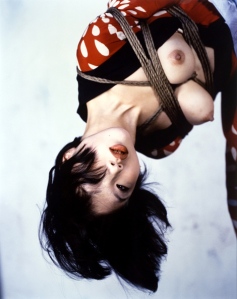I had to complete an image review of 750 words as a short written task so I chose to look at an Araki image as his work is often seen as controversial. So here it is.
Image Review
This untitled image was taken from a collection of bondage and erotic imagery photographed by Nobuyoshi Araki and would have been featured in one of his bondage books from either 2004, 2006 or 2012 but can also be found in Couturier’s ‘Talk About Photography’. The denotational aspects of the image show a female Japanese subject, partially nude and being suspended from the ceiling. The art of Kinbaku, meaning to bind tightly (Jade Rope 2013) plays a major part in Araki’s work, especially here where it draws the viewers eye to the ropes binding the subject’s breasts and arms together. The photograph has many strong elements throughout with the main one being the use of colour; the dark blacks of the hair and part of of the blouse against the bright red of the blouse and lipstick. These colours have connotations that reference lust, desire and temptation which link directly to the idea of bondage and submission and the eroticism that Araki is intending. In contrast to this however, the incorporation of the white polka dots the the subject’s blouse provoke thoughts of youth and innocence and exploitation of a young female which as Natasha Walker states is ‘the main journey for a young girl is expected to lie along her path to winning the admiration of others for her appearance’. She also says that women have decided to enter the sex industry due to ‘the rise of a culture in which it is taken for granted that women will be valued primarily for their sexual attractiveness which has become inescapable for many young women.’ (Walker, N. 2010 p63/64).
It is true that the modern culture has begun an exploration into the idea of bondage and BDSM as it is becoming more accepted in society. Since the ‘sexual revolution’ of the 1970s, people have continued to become more sexually liberated and with the summer of ‘Fifty Shades’ in 2011 people are more willing to experiment as shown in Figures two and three. With this said, the Japanese have been practicing this culture since its origin in the late 1800s/early 1900s (Mantos, J, 2006), only they see it as primarily an artistic form. As Midori states ‘Japanese rope bondage contains an artistic element beyond that of erotic fulfilment.’ (Midori, 2001, p7) however Midori goes onto talk about the difference between a ‘top’ and a ‘bottom’ provoking thoughts of submission. The image itself references submission in the way that the subject has completely no control, although it is suggested that there is some level of control or even rebellion as the subject is clearly looking directly at the camera. If one was to feel more submissive, they would not make eye contact at all similarly to those shown in Figures three and six. The strong facial expression does suggest that she was directed to ‘look sexy’ in order to objectify her and make her appear sexually desirable for men, a technique that has been used widely over the fashion and advertising world. There are elements of bondage in earlier photography; Figures five and six demonstrate that even before the sexual revolution, there was still nude photography and in this case the female is wearing only a piece of ribbon around her neck and the ropes used in figure five have been sexualised through the context of the image.
Many people believe that Araki’s work borders on pornographic and would even say that there is a sense of violence to this photograph however in the current generation the art world is always trying to push the acceptability of sexual imagery. While certain people would say that this kind of imagery is unacceptable for the eyes of younger people and so easily accessible, the counter argument shows that imagery like this can be found in every day life with he most recent example being Miley Cyrus’ music video directed by Terry Richardson, similarly to Figure four, but then again just because it is available does not make it morally right. Nudity has become very common within the world of fashion photography in many different ways, but objectification of women appears to play a large part within the photographical world. It is obvious that Araki is objectifying and exploiting these females but these images ‘play with both exhibitionist desires and instinctual voyeurism’ (Couturier, E. 2012. p184) meaning that people have certain desires that Araki is just highlighting them.
In conclusion, it is apparent that this image appears to be one of controversy, however it is clear that it falls within his particular style of erotic imagery. With this generation continually pushing boundaries when it comes to sexualisation this image is just one of many that will continue to circulate around the photographic world. The image appears to have been portrayed tastefully considering the associated connotations, although the provoking thoughts of violence and objectification will always underlie these styles of photography.

